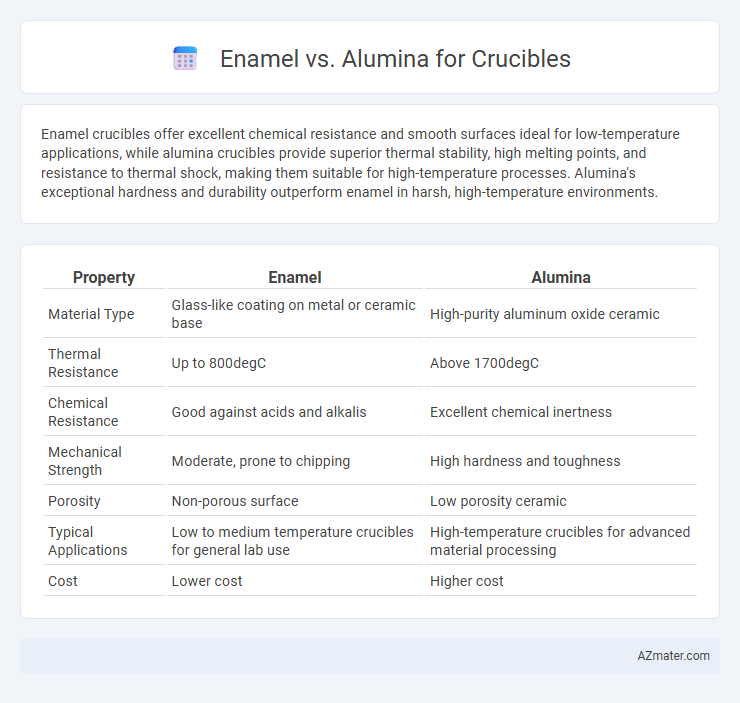Enamel crucibles offer excellent chemical resistance and smooth surfaces ideal for low-temperature applications, while alumina crucibles provide superior thermal stability, high melting points, and resistance to thermal shock, making them suitable for high-temperature processes. Alumina's exceptional hardness and durability outperform enamel in harsh, high-temperature environments.
Table of Comparison
| Property | Enamel | Alumina |
|---|---|---|
| Material Type | Glass-like coating on metal or ceramic base | High-purity aluminum oxide ceramic |
| Thermal Resistance | Up to 800degC | Above 1700degC |
| Chemical Resistance | Good against acids and alkalis | Excellent chemical inertness |
| Mechanical Strength | Moderate, prone to chipping | High hardness and toughness |
| Porosity | Non-porous surface | Low porosity ceramic |
| Typical Applications | Low to medium temperature crucibles for general lab use | High-temperature crucibles for advanced material processing |
| Cost | Lower cost | Higher cost |
Introduction to Crucible Materials
Crucibles are essential containers used in high-temperature applications like metal melting and chemical reactions, where material stability and thermal resistance are critical. Enamel crucibles feature a glassy coating over metal, providing corrosion resistance but limited temperature tolerance up to around 800degC. Alumina crucibles, composed of high-purity aluminum oxide, offer superior thermal stability, chemical inertness, and can withstand temperatures exceeding 1700degC, making them ideal for demanding industrial processes.
What is Enamel?
Enamel is a glassy, vitreous coating fused onto metal or ceramic surfaces to provide a smooth, non-porous, and chemically resistant barrier, ideal for crucibles handling high-temperature reactions. It offers excellent corrosion resistance and thermal stability, preventing contamination and ensuring crucible longevity in demanding laboratory or industrial environments. Enamel-coated crucibles combine durability with ease of cleaning, making them suitable for processes involving aggressive chemicals or metals.
What is Alumina?
Alumina, also known as aluminum oxide (Al2O3), is a crystalline ceramic material renowned for its exceptional hardness, high melting point around 2072degC, and excellent chemical stability, making it ideal for high-temperature crucible applications. Its superior thermal conductivity and resistance to wear and corrosion allow alumina crucibles to withstand aggressive molten metals and harsh chemical environments, outperforming enamel-coated alternatives in durability and longevity. Alumina's minimal porosity and inert nature ensure purity in metal melting processes, reducing contamination risks compared to enamel crucibles, which can chip or degrade under extreme conditions.
Thermal Resistance: Enamel vs Alumina
Enamel crucibles exhibit moderate thermal resistance, typically withstanding temperatures up to 800degC, making them suitable for low to medium temperature applications. Alumina crucibles offer superior thermal resistance, enduring temperatures above 1700degC, which ensures stability and durability in high-temperature processes such as metal melting and ceramic firing. The high melting point and excellent thermal shock resistance of alumina enhance its performance over enamel in demanding thermal environments.
Chemical Durability and Reactivity
Enamel-coated crucibles exhibit moderate chemical durability but can be prone to chipping and corrosion when exposed to strong alkalis or acids, affecting their long-term reactivity resistance. Alumina crucibles provide superior chemical durability due to their inert nature and excellent resistance to corrosion from a wide range of chemicals, including strong acids and high-temperature reactive substances. The low reactivity of alumina ensures enhanced performance in aggressive chemical environments, making it a preferred choice for demanding laboratory and industrial applications.
Temperature Limits and Applications
Enamel crucibles typically withstand temperatures up to 850degC, making them suitable for low to medium heat laboratory applications such as melting wax or small-scale chemical reactions. Alumina crucibles offer significantly higher temperature resistance, often exceeding 1700degC, ideal for high-temperature processes like metal melting, sintering, and advanced ceramics production. The superior thermal stability and chemical inertness of alumina make it preferable in industrial settings requiring extreme heat tolerance and durability.
Mechanical Strength and Longevity
Alumina crucibles exhibit superior mechanical strength with high resistance to thermal shock and wear, making them ideal for handling extreme temperatures in industrial processes. Enamel crucibles, while offering good corrosion resistance, generally have lower mechanical durability and are more prone to chipping under mechanical stress. The longevity of alumina crucibles surpasses that of enamel counterparts due to their robust microstructure and resistance to cracking during repeated thermal cycles.
Cost Comparison and Availability
Enamel crucibles generally cost less than alumina crucibles due to lower raw material and manufacturing expenses, making them a budget-friendly option for many laboratories. Alumina crucibles, while more expensive, offer superior thermal resistance and chemical durability, justifying their higher price in high-demand applications. Availability of enamel crucibles is widespread and consistent, whereas alumina crucibles may have limited supply depending on purity and size requirements, potentially affecting procurement timelines.
Best Uses: Enamel Crucibles vs Alumina Crucibles
Enamel crucibles are best suited for low to moderate temperature applications and chemical experiments involving acids due to their corrosion resistance and affordability. Alumina crucibles excel in high-temperature environments, often exceeding 1700degC, making them ideal for metal melting, ceramic processing, and high-purity analytical work. Selecting between enamel and alumina crucibles depends on the thermal stability, chemical resistance, and cost requirements of the specific application.
Choosing the Right Crucible Material
Choosing the right crucible material involves comparing enamel and alumina based on temperature resistance and chemical durability. Alumina crucibles withstand extremely high temperatures up to 1750degC and resist corrosion from acids and salts, making them ideal for laboratory and industrial applications requiring thermal stability. Enamel crucibles offer chemical inertness and moderate temperature resistance, best suited for low to medium temperature processes where lightweight and ease of cleaning are priorities.

Infographic: Enamel vs Alumina for Crucible
 azmater.com
azmater.com